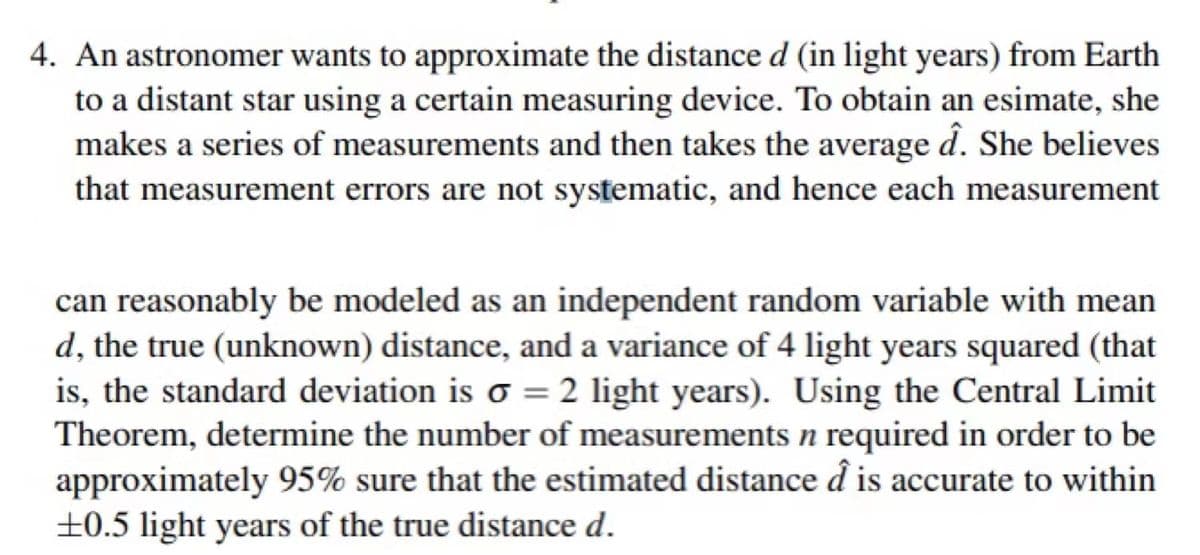4. An astronomer wants to approximate the distance d (in light years) from Earth to a distant star using a certain measuring device. To obtain an esimate, she makes a series of measurements and then takes the average d. She believes that measurement errors are not systematic, and hence each measurement can reasonably be modeled as an independent random variable with mean d, the true (unknown) distance, and a variance of 4 light years squared (that is, the standard deviation is o = 2 light years). Using the Central Limit Theorem, determine the number of measurements n required in order to be approximately 95% sure that the estimated distance d is accurate to within +0.5 light years of the true distance d.
4. An astronomer wants to approximate the distance d (in light years) from Earth to a distant star using a certain measuring device. To obtain an esimate, she makes a series of measurements and then takes the average d. She believes that measurement errors are not systematic, and hence each measurement can reasonably be modeled as an independent random variable with mean d, the true (unknown) distance, and a variance of 4 light years squared (that is, the standard deviation is o = 2 light years). Using the Central Limit Theorem, determine the number of measurements n required in order to be approximately 95% sure that the estimated distance d is accurate to within +0.5 light years of the true distance d.
A First Course in Probability (10th Edition)
10th Edition
ISBN:9780134753119
Author:Sheldon Ross
Publisher:Sheldon Ross
Chapter1: Combinatorial Analysis
Section: Chapter Questions
Problem 1.1P: a. How many different 7-place license plates are possible if the first 2 places are for letters and...
Related questions
Question
4

Transcribed Image Text:4. An astronomer wants to approximate the distance d (in light years) from Earth
to a distant star using a certain measuring device. To obtain an esimate, she
makes a series of measurements and then takes the average d. She believes
that measurement errors are not systematic, and hence each measurement
can reasonably be modeled as an independent random variable with mean
d, the true (unknown) distance, and a variance of 4 light years squared (that
is, the standard deviation is o = 2 light years). Using the Central Limit
Theorem, determine the number of measurements n required in order to be
approximately 95% sure that the estimated distance d is accurate to within
±0.5 light years of the true distance d.
Expert Solution
This question has been solved!
Explore an expertly crafted, step-by-step solution for a thorough understanding of key concepts.
This is a popular solution!
Trending now
This is a popular solution!
Step by step
Solved in 2 steps with 2 images

Recommended textbooks for you

A First Course in Probability (10th Edition)
Probability
ISBN:
9780134753119
Author:
Sheldon Ross
Publisher:
PEARSON


A First Course in Probability (10th Edition)
Probability
ISBN:
9780134753119
Author:
Sheldon Ross
Publisher:
PEARSON
